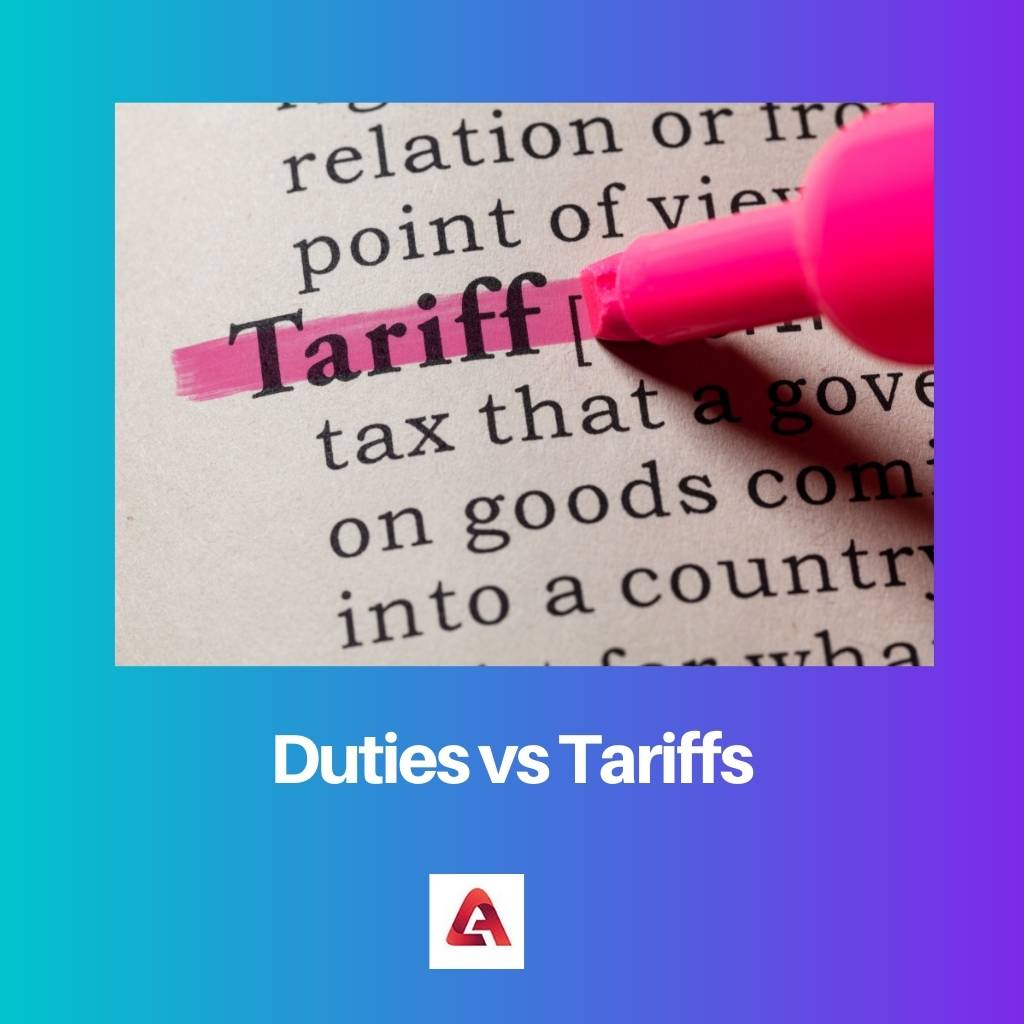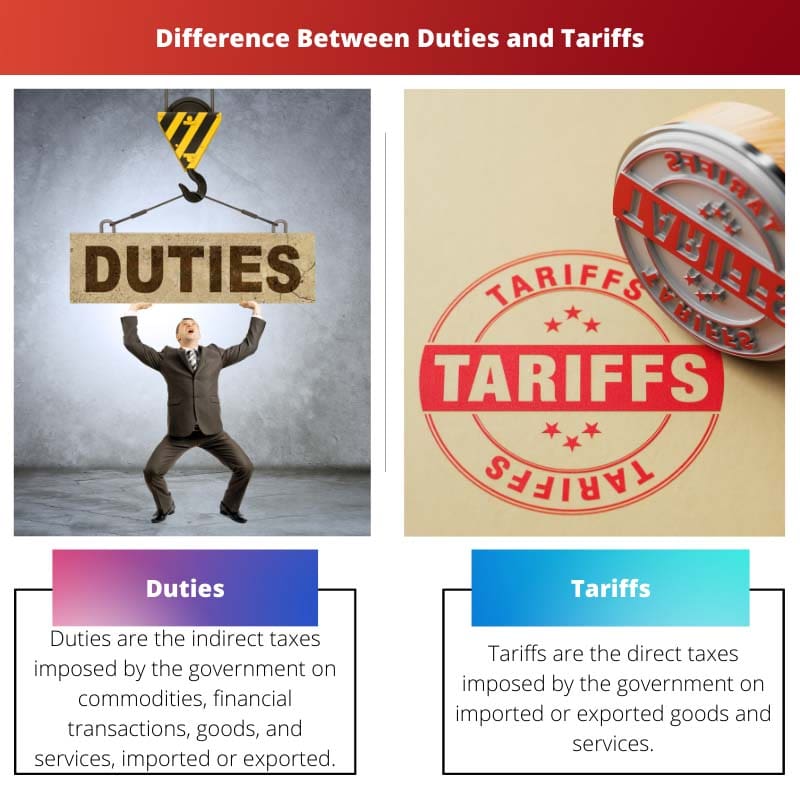Buying any product does not just involve giving money and taking the product. There are a lot more processes behind the scene. Before a product comes into the market for selling, there are different prices included in the cost of the product.
The amount taken by the government for goods and services is called a ‘tax.’ The government imposes a tax in various forms as direct tax and indirect tax. Direct tax is called a tariff, while indirect tax is a duty.
Key Takeaways
- Duties are taxes governments impose on imported or exported goods, while tariffs are taxes specifically imposed on imported goods.
- Duties are a fixed percentage of the goods’ value, while tariffs vary depending on the type of goods.
- While duties aim to raise government revenue and protect domestic industries, tariffs limit imports to protect domestic industries from foreign competition.
Duties vs Tariffs
The difference between Duties and Tariffs is that Duties are the indirect tax imposed by the Government on the consumer. On the other hand, Tariffs are the direct tax applied to goods imported from a different country. These taxes help domestic industries to grow.

Duties are imposed on the goods of a single person who brings in something from another country. These taxes are collected to protect the industries of the country. Types of duties include anti-dumping taxes, trade tariffs, export duties, and excise duties.
These are levied as import duties applied to goods entering the country.
Tariffs can be understood as a hurdle the free trade between two countries. It is the amount a government should pay either for export or import to marketing products. Tariffs are primarily imposed on imported goods and hardly on exported goods.
That’s why consumers have to pay extra costs for imported items. So, the government earns with this, and the country’s GDP increases.
Comparison Table
| Parameters of Comparison | Duties | Tariffs |
|---|---|---|
| Description | Duties are the indirect taxes imposed by the government on commodities, financial transactions, goods, and services, imported or exported. | Tariffs are the direct taxes imposed by the government on imported or exported goods and services. |
| Types | Excise duty, customs duty, stamp duty, education cess. | Specific tariff, Ad Valorem tariff. |
| Nature | Indirect in nature, as different taxes are included in the final price of a good. | Direct in nature, as tariff rates are fixed on goods being imported. |
| Types of Goods | Duties are collected on imported, exported, and goods that are manufactured in the country. | Tariffs are collected on imported and exported goods. |
| Benefit | The government benefits, which helps increase the country’s economy. | The government and the country are benefited. |
What are Duties?
Duties are the taxes imposed by the government on the company and individual that sends or receives goods from one country to other and also on the goods manufactured in the country, varying from country to country and product to product.
Duties are imposed to raise the revenue of a country by protecting domestic industries from foreign competition. Two types of duties are excise duty and customs duty.
Excise duty is imposed on the goods that are manufactured locally. It is imposed in addition to indirect tax, so the manufacturer or seller who pays excise duty tries to recover the loss by increasing the price of goods produced by the customer.
A Customs duty is an indirect tax imposed on a consumer who imports goods. It is set by the government to support local industries.
It is levied by customs on imported goods based on weight, value, dimensions, etc., and varies from product to product and country in which it is manufactured. Custom duty is further divided into primary, countervailing, and anti-dumping duties.

What are Tariffs?
Tariffs are the taxes imposed when the government imports goods and services. Tariffs are levied because the government does not want its country’s economy to be less competitive with other countries.
Tariffs increase the price of imported goods; hence, due to increased costs, imported goods are less desirable. Because of the increase in the price of goods, more domestic companies will manufacture the goods.
This will protect the domestic industries; thus, people can buy products cheaper than imported ones.
The government imposes different types of tariffs, but the two essential and regularly applied taxes are the Specific and the Ad Valorem tariff. A specific tariff is a fixed tariff on one unit of goods imported and varies by the type of good.
Ad Valorem tariff is a certain tariff percentage calculated on the total value of imported goods.

Main Differences Between Duties and Tariffs
- Duties are the taxes collected by the government on import and export goods. At the same time, tariffs are the taxes levied on imported goods.
- Duties are imposed as indirect taxes as they are added after adding the cost of products. Tariffs are direct taxes, and imported goods are classified under HTS, i.e., harmonized tariff system codes. HTS codes determine the tariff rate.
- The government decides tariff rates according to which duties are collected as the amount on the goods being imported and exported.
- Two principal duties are customs duty and excise duty, whereas two significant types of tariffs are specific tariff and ad valorem tariff.
- Duties may vary between 0% to 100%, while tariffs can be calculated by dividing total tariff revenue by the total value of imports.


I found this article to be incredibly enlightening and comprehensive. The breakdown of the nuances between duties and tariffs is remarkable and provides valuable insights into international trade practices.
Well said, Zpalmer. The depth of analysis is truly commendable.
This article makes it so clear to understand the nuanced differences between duties and tariffs, making it an invaluable resource for those seeking to comprehend trade taxation.
I couldn’t agree more, Adrian. The detailed breakdown is truly commendable.
This well-structured article effectively highlights the differences between duties and tariffs. It’s an insightful and educational read for anyone interested in international trade practices.
Absolutely, Taylor. This article is a valuable resource for those seeking to comprehend the complexities of trade taxation.
I couldn’t agree more, Taylor. The detailed comparison is truly remarkable.
This article’s detailed analysis of duties and tariffs provides a comprehensive understanding of the complexities of international trade. It’s a valuable resource for anyone looking to delve deeper into this topic.
Absolutely, Campbell. The article is a valuable and informative read for anyone interested in trade taxation.
The article’s thorough comparison of duties and tariffs is educational and insightful. It has broadened my understanding of international trade practices and the implications of these taxes.
Absolutely, Graham. It’s a great way to gain a deeper understanding of tax policies around the world.
I’m glad I’m not the only one who found this article to be a valuable and informative read.
An enlightening and educational read on the complexities of international trade taxation. The article effectively distinguishes between duties and tariffs, offering valuable insights into this aspect of commerce.
This is an insightful piece that provides a detailed and clear overview of the distinctions between duties and tariffs. Kudos to the author for the clarity and depth of analysis.
Well said, Bross. The depth of analysis is truly commendable.
I couldn’t agree more, Bross. The article is a great resource for anyone looking to understand the complexities of international trade.
The detailed comparison of duties and tariffs in this article is exceptional. It provides a wealth of knowledge on an important aspect of international trade, making it an invaluable resource for readers.
I couldn’t agree more, Kyle15. The clarity and depth of analysis are truly commendable.
This article provides a comprehensive breakdown of the differences between duties and tariffs. It’s a great source of information for anyone looking to understand the complexities of international trade.
Absolutely, Lizzie. I found it incredibly enlightening and well-structured.
This article offers a comprehensive comparison of duties and tariffs, shedding light on their implications for international trade. It’s a valuable resource for anyone seeking to understand these complex tax policies.
Well said, Gavin Owen. It’s a great way to gain a deeper understanding of international trade practices.